History of Delta Air Lines
Delta Air Lines is a major American airline with a history back to 1924.
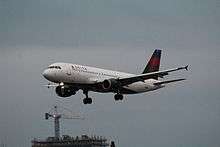
1924 through 1940
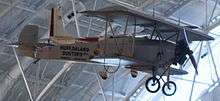
Delta's origins can be traced to a decision by B. R. Coad and Collett E. Woolman. Coad was an employee of the U.S. Department of Agriculture's field laboratory in Tallulah, Louisiana; Woolman was with its extension service. They worked on finding a solution to the boll weevil infestation of cotton crops and concluded that the "dusting" of an insecticide powder from the air would be the most effective form of treatment. From this decision, Huff Daland Dusters Incorporated was born. It was founded on May 30, 1924, in Macon, Georgia, and became the world's first aerial crop dusting company. The company moved to Monroe, Louisiana, in 1925. Woolman left his position with the extension service and in the off-season traveled with the company to Peru, where they helped to establish crop-dusting and passenger services. With this experience, Woolman returned to the United States and in 1928 raised the capital to buy Huff Daland, purchasing it on September 13, 1928, and renaming the company Delta Air Service, with its headquarters in Monroe. The name Delta, referring to the Mississippi Delta, was suggested by Catherine Fitzgerald, a secretary who later would rise to the rank of an executive in the company.[1]
In 1930 the Delta Air Corporation (as it was then called) expanded eastward to include service to Atlanta, the fastest-growing city in the South, and westward to Fort Worth, Texas.[1] This service was terminated in 1930 after the "Spoils Conference", when the Post Office awarded the route to American Airlines. Delta's lack of success in winning a commercial airmail contract—the bread and butter of any aspiring airline—jeopardized its existence, and the company suspended passenger service.[1]
A reprieve came for Delta on the heels of the "airmail scandal", when the U.S. Congress enacted the Air Mail Act of 1934. Woolman secured a low-bid contract for the new Route 33 airmail service between Dallas and Charleston, South Carolina, via Atlanta.[1] In August of that same year Delta resumed passenger services, flying used Stinson "T" Trimotors,[1] with a route from Charleston, SC to Fort Worth, with stops in Columbia, SC, Augusta, Atlanta, Birmingham, and Meridian along the way.[2]
1940s and 1950s
In 1941 Delta moved its headquarters from Monroe to Atlanta.
Until 1941 Delta's network was an unbranched string of twelve cities from Fort Worth to Charleston SC. That December it scheduled ten departures a day at Atlanta: three to Ft Worth, one to Birmingham and two each to Cincinnati, Charleston and Savannah. Those ten flights and their returns were Delta's whole schedule.

In 1943 Delta added New Orleans and in 1945 Chicago and Miami. Delta purchased Chicago and Southern Air Lines in 1953 and flew under the name Delta-C&S for the next two years. This added a north-south network from Chicago and Detroit to Houston and New Orleans — and Delta's first international route, New Orleans to Caracas via Havana.[3] The network expanded to Washington DC and New York in 1956; like Braniff, Delta initially flew only to Newark, but in 1957-58 both airlines added flights to Idlewild. Delta had no direct flights between the Northeast and Florida until it merged Northeast Airlines in 1972.
| Delta | Northeast | C&S | |
|---|---|---|---|
| 1951 | 402 | 88 | 200 |
| 1955 | 1008 | 116 | (merged DL) |
| 1960 | 1870 | 565 | |
| 1965 | 4304 | 666 | |
| 1970 | 9713 | 1856 | |
| 1975 | 16460 | (merged) |
1960s and 1970s
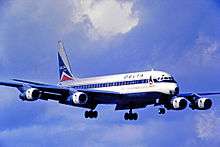
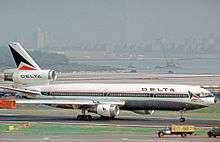
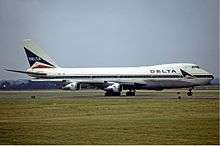
Delta added jet airliners to its fleet in the 1960s; the Douglas DC-8 entered service in September 1959. Delta's new red, white, and blue triangle logo (the "widget") on their aircraft represented the jet's swept wing, as well as the Greek letter delta. Convair 880s were added in 1960 (they set a coast-to-coast record)[4] and in 1965 the DC-9. Delta became an all-jet airline in 1970.[1]

In 1961 Delta (and National) routes reached west to California; Delta purchased Northeast Airlines in 1972.[1]
Delta launched its cargo service Delta Air Express in 1975.[5]
1980s
Delta launched its first frequent flyer program in 1981 which became the SkyMiles program in 1995. In 1983, Delta took delivery of its first Boeing 767-200, named the Spirit of Delta, which was paid for "by voluntary contributions from employees, retirees and Delta's community partners." The effort, called Project 767, was spearheaded by three Delta flight attendants to show the employees' appreciation to Delta for solid management and strong leadership during the first years following airline deregulation."[6] The airplane remained in the Delta fleet until 2006, and was repainted in a commemorative paint scheme and toured the country to celebrate the airline's 75th anniversary in 2004.[7] In 1987 Delta merged with Western Airlines.
1990s
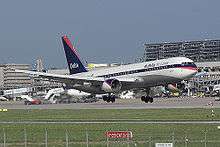
In 1990, Delta became the first U.S. airline to operate the McDonnell Douglas MD-11 aircraft,[8] leasing two from Mitsui.
Delta expanded dramatically by purchasing most of Pan Am's European routes after Pan Am declared bankruptcy in 1991. Delta initially explored a joint divvying-up of Pan Am's assets with United Airlines where Delta would take over the New York-based European operations and United would take over the Miami-based Latin American operations, but the two carriers reached an impasse over which would assume the Pan Am Miami-London route. On September 1, Delta acquired Pan Am's East Coast and European routes including intra-European routes from the Frankfurt hub, (IGS routes to and from Berlin were acquired by Lufthansa) and assumed a controlling interest in the remainder of Pan Am, which continued to operate routes from Miami to London, Paris and Latin America. The total price for these assets was $1.3 billion.[9]
Although Delta initially promised further equity injections to keep Pan Am afloat, it refused to do so only a month later, which forced Pan Am to cease operations on December 4.[10] United purchased the remaining assets of Pan Am a few days later, including transatlantic routes from Miami, for a total of $135 million.[9]
The Pan Am creditors' committee sued Delta for more than $2.5 billion on December 9.[11]
The Pan Am transaction gave Delta the largest transatlantic route network among U.S. airlines. Because of these acquisitions, Delta became and remains the largest U.S. transatlantic carrier, in terms of passengers carried and number of flights operated. The ex-Pan Am routes acquired by Delta included Detroit to London, despite Northwest Airlines' objections due to Delta's small presence in Detroit and Northwest's comparatively larger operations.[12] Northwest later attempted to buy US Air's (now American Airlines) Baltimore-London route for $5 million and transfer the route to Detroit[13] but ended up buying the route from Delta in 1995[14] for a rumored $32 million.
Throughout the 1990s, Delta maintained a secondary hub at Portland for its Asia operations. In addition to regularly scheduled flights to Delta's primary hubs during this time (Atlanta, Cincinnati, Dallas, and Salt Lake City), several of Delta's flights to Asia were routed from Portland and Los Angeles, using L-1011 and MD-11 aircraft. Destinations included Bangkok, Fukuoka (resumed December 28, 2011 from Honolulu as a seasonal route), Hong Kong, Manila, Nagoya, Seoul, Taipei, and Tokyo (resumed June 3, 2009 replacing Northwest Airlines route). Delta was one of the airlines targeted in the failed Operation Bojinka plot: the conspirators planned to bomb a Delta MD-11 flying from Seoul to Bangkok via Taipei on January 21, 1995. Today, all Asia operations from Portland and Los Angeles have ceased (except for Portland-Tokyo and Los Angeles-Tokyo).[15]
In 1998, Delta and United Airlines introduced a marketing partnership that included a reciprocal redemption agreement between SkyMiles and Mileage Plus programs and shared lounges.[16] This scheme allowed members of either frequent flier program to earn miles on both carriers and utilize both carriers' lounges. Delta and United attempted to introduce an even closer codeshare agreement, but this was deal was effectively killed by ALPA.[17]
2000s
In 2000, Delta partnered with AeroMéxico, Air France, and Korean Air to form SkyTeam, a global alliance. Three years later, Delta began the largest domestic codeshare alliance with Continental Airlines and Northwest Airlines. Today SkyTeam is the second largest airline alliance in the world (after Star Alliance).[18]
Delta's short-lived Los Angeles focus city was significantly reduced in 2008, ending the build up toward hub status as Delta went from a high of 48 destinations from the airport to just 17.[19]
Fleet transformation in the early 2000s
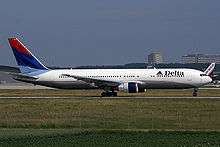
In an effort to simplify its fleet and capitalize on cross-platform compatibility, not only in pilot training but also maintenance, the airline began to retire its trijets (three-engine planes) in favor of twinjets (two-engine planes). Delta's entire active fleet is now composed of twinjets, except for the 747s. The airline is now the world's largest operator of 767 aircraft.
- The Lockheed L-1011 was, for many years, the workhorse of the fleet and backbone of Delta's international network, numbering as high as 56 in service at one time. The last L-1011 (N728DA) was retired on July 31, 2001. The final flight operated as Flight 1949 from Orlando to Atlanta. The Lockheed L-1011's were replaced with the Boeing 767-400.
- The airline's many Boeing 727s were completely replaced with Boeing 737-800s in 2003.
- Delta operated its last MD-11 flight on January 1, 2004, operating as Flight 56 from Narita International Airport to Atlanta. This concluded the MD-11s relatively short service in the fleet. MD-11 aircraft have been replaced with Boeing 777-200ERs. On September 23, 2004, a Delta spokesperson confirmed plans to sell 8 MD-11s to FedEx Express. The remainder MD-11s were either sold to World Airways for charter use or converted to freighters for UPS Airlines.
Bankruptcy
As early as 2004, in an effort to avoid bankruptcy, Delta began restructuring the company, which included job cuts and an aggressive expansion of Atlanta operations by some 100 new flights, making it a 'super-hub' and requiring the airline to spread its flight schedule more evenly across the day.[21]
On August 15, 2005, in an SEC filing, Delta finalized a deal to sell Delta Connection carrier Atlantic Southeast Airlines (ASA) for $425 million in cash to SkyWest Airlines in an effort to obtain money to avoid bankruptcy. Analysts called the move a desperate one, estimating ASA's worth at around $700–$800 million – a price which SkyWest would not have been willing to pay.[22]
Delta sought protection from its creditors under Chapter 11 of the U.S. Bankruptcy Code on Sept. 14, 2005, via a filing with the U.S. Bankruptcy Court for the Southern District of New York, in Manhattan; the company's liabilities included some $28.27 billion of total debt. Ironically, rival carrier Northwest Airlines also sought Chapter 11 protection that same day via a filing with the same court; Delta and Northwest would eventually merge several years later, after both companies had restructured and had emerged from bankruptcy, with Delta as the surviving corporate entity.
In December 2005, Delta cut 26% of its flights at its Cincinnati hub and redeployed the aircraft to its hubs in Atlanta and Salt Lake City.[23]
Reorganization during bankruptcy

In 2005, Delta accelerated its restructuring, targeting an additional $3 billion per year in cost reductions by 2007. Of that, $970 million was to come from debt relief, lease and facility savings, and previously commenced fleet modifications. Non-union workers' salaries were to be reduced by a minimum of 9% across the board, with a 15% reduction for executive officers and a 25% pay cut for CEO Gerald Grinstein. In December 2005, the Delta pilots agreed to an additional temporary 14% cut in pay, piggybacking onto the 32.5% taken at the beginning of 2005. This cut was made permanent with the ratification of an agreement in June 2006. Additionally, the company planned to lay off between 7,000 and 9,000 of its 52,000 employees.[24]
In 2006, Delta purchased rights to fly between New York City and London from United Airlines.[25]
On February 24, 2006, Delta, along with Continental Airlines and FedEx Express, saw future operations to Venezuela severely affected by President Hugo Chávez's decision to restrict flights coming into that South American country from the United States.[26]
Based on all of these new initiatives, Delta projected a return to profitability by late 2007, based on a crude oil price model of $66 per barrel, in contrast to other bankrupt carriers' restructuring modeled on $55 per barrel. Delta would eventually reach this goal of full year profitability in 2007.[27]
Starting in 2007, Delta began offering on-demand programming on all flights longer than four hours at its main hubs in New York City, Salt Lake City, and Atlanta. This countered entertainment offerings of other airlines like JetBlue Airways, and took after Song's services. Live programming and music are free, and movies are available on demand for a nominal fee in coach and for free in first class.[28] Delta also installed an improved in-flight entertainment system on internationally configured aircraft, featuring a personal selection of movies. The system was installed in all classes on Boeing 767-400ER and 777-200ER aircraft, and in the BusinessElite section on Boeing 767-300ER aircraft.[29]
On November 9, 2006, the airline recalled 1,000 flight attendants that were previously laid off. Delta also exhausted its pilot recall list and, in December 2006, began accepting pilot applications for the first time in 5 years. They expected to take on close to 200 first officers through 2007.[30]
Failed takeover attempt by US Airways
On November 15, 2006, Bloomberg reported that US Airways Group, the parent of US Airways, proposed a takeover of Delta for $8 billion in cash and stock.[31]
In addition to Delta management, Delta employees appeared to be extremely skeptical of US Airways management's claims that a merger would result in no job reductions and provide a more secure future for a combined entity. Employees had started wearing "Keep Delta My Delta" buttons and campaigning to raise public awareness of their opposition to the proposed takeover.[32]
On December 19, 2006, Delta rejected US Airways Group's proposed merger. The airline also launched a media campaign against the merger to raise public support. The campaign, "Keep Delta My Delta", was picked up from the employee grassroots effort of the same name. The effort's website harbored an e-petition, quotes from prominent dissidents, and the effects the merger could have on selected localities. In its report, Delta cited many reasons for rejecting the bid, including it would lead to worse customer service, possible layoffs, an inefficient carrier, the carrier with the largest debt-load in the industry, and near-monopoly powers.[33]
On December 20, 2006, Delta and its financial advisor, the Blackstone Group, declared that Delta would be valued at between $9.4 billion and $12 billion after emerging from bankruptcy, which would (at the time of this writing ) give it a market capitalization comparable to that of Southwest Airlines Co. or greater than that of American Airlines' AMR Corp. and Continental Airlines, Inc. combined. US Airways Group CEO Doug Parker stated that Delta's self-valuation lacked credibility and was unrealistic.[34] Delta CEO Gerald Grinstein retorted by stating that the Tempe-based airline was "the worst of all potential merger partners".[35]
On January 10, 2007, US Airways raised its bid by 20%, to $10.2 billion. The revised offer was set to expire by February 1 unless Delta's creditors opened the airline's books to US Airways and delayed a scheduled February 7 court hearing pertaining to Delta's reorganization plan.[36] Delta responded with a statement, claiming that "...the revised proposal does not address significant concerns that have been raised about the initial US Airways proposal and, in fact, would increase the debt burden of the combined company by yet another $1 billion."[37] That same day Delta Air Lines was speculated to be in talks with Continental Airlines, Northwest Airlines and United Airlines to fend off the US Airways bid.[38] CEO Gerald Grinstein, however, denied that any serious negotiations were ongoing with Northwest or any other airline.
On January 28, 2007, US Airways holding company raised its bid by another $1 billion according to the Wall Street Journal,[39] but company spokesmen denied any change. On January 31, 2007, Delta's creditors rejected US Airways' hostile takeover attempt, and US Airways withdrew its offer to buy Delta. On the same day, executives and employees of the company gathered to celebrate the re-lighting of the historic "FLY DELTA JETS" sign at the company's main hub, Hartsfield-Jackson Atlanta International Airport.[40][41]
Emergence from bankruptcy
.jpg)
On April 25, 2007, the airline's bankruptcy plan was approved by the bankruptcy court. On April 30, 2007, Delta Air Lines emerged from bankruptcy protection as an independent carrier. Delta also unveiled a new logo, reminiscent of its logo from the 1970s and 1980s, and a new paint scheme.
Delta's previous stock was canceled as of Monday, April 30, 2007, and new shares are trading on a "when issued" basis on the New York Stock Exchange. These shares began trading normally on Thursday, May 3, 2007. The starting price was around $20.00 a share, and went up to as high as $23.35. But investors showed little confidence in the stock as the price fell to $19.00 later in the week.[42]
Upon exiting bankruptcy, Delta increased operations at Los Angeles International Airport by 50%,[43] thus establishing Los Angeles as Delta's second West Coast hub and new potential Asian gateway with a total of 99 daily departures.
Post-bankruptcy
On May 10, 2007, Delta began a partnership with US Helicopter, who provides service from John F. Kennedy International Airport to several helipads in downtown Manhattan.[44]
On July 12, 2007, Delta and its SkyTeam partners forfeited slots in the European Union to relieve antitrust concerns.[45]
On August 21, 2007, Delta named Richard Anderson, former CEO of Northwest Airlines and executive at UnitedHealth Group, as a replacement for outgoing CEO Gerald Grinstein. Anderson assumed the post on September 1.[46]
On November 14, 2007, Pardus Capital Management LP, a hedge fund that owns 7 million shares of Delta and 5.6 million shares of United, called for the two carriers to merge. This action sent shares of both airlines up. However, the two airlines quickly denied official talks of any merger.[47][48] [49]
Japan Airlines shareholder negotiations
In an effort to expand Delta's Tokyo hub operations at Narita International Airport after the merger with Northwest, on September 11, 2009, Japan's NHK reported that Japan Airlines (JAL) was seriously considering allowing Delta to become a majority shareholder. However, JAL is a member of Oneworld, which is rival to Delta's SkyTeam alliance.[50][51] In addition, it was reported that JAL was in talks with Delta's partner, Air France-KLM, and JAL's Oneworld partner and Delta's rival, American Airlines, for equity investments in the airline.[52]
On January 4, 2010, the Yomiuri Shimbun reported that JAL and the Japanese government-backed Enterprise Turnaround Initiative Corporation of Japan would likely choose to form a business and capital tie-up with Delta, and that JAL would enter the SkyTeam alliance as part of the deal. The move, according to the report, would reduce JAL's international flight operations in favor of code-share agreements with Delta. The report also said that American Airlines had begun procedures to end negotiations with JAL.[53] A JAL spokesman denied the report, stating that negotiations with Delta and American were continuing.[54]
Yomiuri reported, on January 16, 2010, that Delta had reached an agreement with JAL on a tie-up consisting mostly of code-sharing flight services. JAL and Delta intended to sign the agreement after JAL's bankruptcy protection proceedings began, and both airlines would apply for antitrust immunity with the United States Department of Transportation. Also, JAL announced that it would leave Oneworld and would join the SkyTeam alliance.[55][56] JAL was expected to officially announce the tie-up with Delta and the switch from Oneworld to SkyTeam on February 1, 2010, the day Delta's and Northwest's reservation systems would merge.
On February 8, 2010, Japan Airlines chose to remain partners with American Airlines and stay in Oneworld, ending talks with Delta.[57]
2010s
Merger with Northwest Airlines


On April 14, 2008, following merger talks first reported on January 15, 2008,[58] Delta and Northwest Airlines announced that they would merge to create the world's largest airline under the Delta name.[59] The merger formed the largest commercial airline in the world, with 786 aircraft.[60] The Atlanta-based combined airline will have $17.7 billion enterprise value. The company also stated on April 14, 2008 that it agreed with its pilot union to extend the existing collective bargaining agreement through the end of 2012. The agreement, subject to a vote by the pilots, provides Delta pilots a 3.5 percent equity stake in the created new airline.[61]
Northwest WorldPerks was merged into Delta SkyMiles on October 1, 2009. Operating certificates were merged on December 31, 2009. Reservations systems were merged on January 31, 2010, officially retiring the Northwest brand.[62][63]
Approval

The deal passed anti-trust overview from the Department of Justice; as most analysis expected, the deal was not blocked, due to the minimal overlap between the two airlines' routes and very little threat to competition in the industry.[64] The merger was also expected to be the subject of several hearings on Capitol Hill. Representative Jim Oberstar of Minnesota, who also serves as chair of the House Committee on Transportation and Infrastructure, made clear his opposition to the merger, and he fought it in Washington. There was also strong support for the merger at the Capitol from legislators from Georgia, including Representative Lynn Westmoreland, Representative David Scott, and Senator Johnny Isakson.[65] On August 7, 2008, the merger won regulatory approval from the European Union.[66]
After a six-month investigation, government economists concluded the merger would likely drive down costs for consumers without curbing competition.[67] On October 29, 2008, the United States Department of Justice approved the merger between Delta Air Lines and Northwest.[68]
Transition
All of Northwest's aircraft were eventually repainted in Delta's livery. Northwest's three US hubs were rebranded and gates have been consolidated along with other US airports. In airports where Northwest and Delta operated in separate terminals, one airline moved to another's terminal.
In May 2012 the final group of employees and flight attendants began to work together. They had previously voted No to Union representation.
China Eastern Airlines
In 2015 the airline entered a partnership with China Eastern Airlines in which Delta will buy a 3.55% share in China Eastern for $450m.[69]
Grounding of flights in 2016
In August 2016 thousands of airline flights were delayed or cancelled due to a technology issue. Tens of thousands of people were stranded worldwide.[70][71][72][73]
References
- 1 2 3 4 5 6 7 This article incorporates material written by Jamil S. Zainaldin of the Georgia Humanities Council of May 31, 2007 for the New Georgia Encyclopedia ("NGE"), posted or last updated 1302. All derived works must credit the NGE and the original author.
- ↑ "Delta Air Lines; Delta Through the Decades". Delta.com. Retrieved 2013-01-30.
- ↑ "Delta Through the Decades". Delta.com. April 30, 2007. Archived from the original on April 20, 2008. Retrieved 2009-03-01.
- ↑ A Texaco ad in Aviation Week September 19, 1960 p48 says flight time San Diego to Miami was 3 hr 31 min 45 sec (date not given).
- ↑ "Delta Through the Decades". Delta.com. April 30, 2007. Archived from the original on April 20, 2008. Retrieved 2009-03-01.
- ↑ "Spirit of Delta". Retrieved 2006-09-17.
- ↑ "The Spirit of Delta launched to commemorate anniversary". Atlanta Business Chronicle. April 23, 2004. Retrieved 2006-09-17.
- ↑ MD-11 jumbo jet arriving to fly Delta into the future, Atlanta Journal-Constitution December 22, 1990
- 1 2 Petzinger, Thomas (1996). Hard Landing: The Epic Contest For Power and Profits That Plunged the Airlines into Chaos. Random House. ISBN 978-0-307-77449-1.
- ↑ Pan Am Faces Shutdown Today Without Financing, Associated Press December 4, 1991
- ↑ "Pan Am, Creditors Sue Delta – The Washington Post – HighBeam Research". Highbeam.com. December 9, 1991. Retrieved 2009-03-01.
- ↑ "Company news; Pan American Route Transfer". New York Times. April 1, 1992. Retrieved 2013-01-30.
- ↑ "Company News; Northwest Agrees To Pay $5 Million For London Route". New York Times. April 16, 1993. Retrieved 2013-01-30.
- ↑ "History". MetroAirport.com. Retrieved 2009-03-01.
- ↑ "Complaints make Portland-Tokyo flight bumpy for Delta". The Oregonian. September 3, 2009.
- ↑ "Delta Air Lines and United Airlines to end marketing relationship|Airline Industry Information|Find Articles at BNET.com". Findarticles.com. July 29, 2003. Retrieved 2009-03-01.
- ↑ "News & Analysis". FrequentFlier.com. Retrieved 2009-03-01.
- ↑ "SkyTeam Alliance Members – Member Airlines of SkyTeam". Businesstravel.about.com. April 10, 2012. Retrieved 2013-01-30.
- ↑ "Delta Air Lines Plan of Reorganization (LAX included in 5 hubs/gateways, pgs 23 and 24)" (PDF). Retrieved 2006-12-20.
- ↑ "Delta Logo Timeline". Retrieved June 27, 2010.
- ↑ "Guiding Pilots to their Professional Goals". FLTops.com. Retrieved 2009-03-01.
- ↑ Delta Air Lines Reaches Definitive Agreement to Sell Atlantic Southeast Airlines to SkyWest (Press release), Delta Air Lines, 2005-08-15, archived from the original on November 18, 2005
- ↑ Delta Air Lines Strengthens Domestic Hubs, Offers Customers More International Choices with Winter Schedule (Press release), Delta Air Lines, 2005-09-07, archived from the original on November 20, 2005
- ↑ Delta Air Lines Steps Up Transformation Plan to Accelerate Path to Profitability (Press Release), Delta Air Lines, 2005-09-22, archived from the original on February 20, 2006
- ↑ "Delta Air Lines Seeks 'Crown Jewel' for New York-JFK Hub: Nonstop Flights to London". News.delta.com. July 28, 2006. Archived from the original on May 27, 2008. Retrieved 2009-03-01.
- ↑ Bachelet, Pablo; Jane Bussey; Ina Paiva Cordle (February 25, 2006). "Chávez restricting U.S. flights". The Miami Herald. Retrieved 2007-01-10.
- ↑ "Delta Air Lines in black for 2007; Business Courier of Cincinnati, Wednesday, January 23, 2008". Cincinnati.bizjournals.com. January 23, 2008. Retrieved 2013-01-30.
- ↑ Adams, Marilyn (September 13, 2006). "Delta plans to keep fliers entertained". USA Today. Retrieved 2006-09-17.
- ↑ "Delta Continues Successful International Expansion with New Nonstop Service to Dubai, Seoul, three Destinations in Europe" (Press release). Delta Air Lines. October 12, 2006. Retrieved 2006-10-12.
- ↑
- ↑ Schlangenstein, Mary (November 15, 2006). "US Airways Proposes Merging With Delta Air Lines". Bloomberg. Retrieved 2007-01-10.
- ↑ Howe, Peter J. (November 23, 2006). "Delta workers see trouble in takeover bid". The Boston Globe. Retrieved 2007-01-10.
- ↑ Keep Delta My Delta, archived from the original on December 31, 2006
- ↑ Grantham, Russell (December 22, 2006). "US Airways CEO: Delta's self-valuation 'lacks credibility'". Atlanta Journal-Constitution. Retrieved 2006-12-22.
- ↑ Gibbons, Tom (December 24, 2006). "Money talks in bid to acquire Delta". East Valley Tribune. Retrieved 2006-12-24.
- ↑ Schneiderman, R.M. (January 10, 2007). "US Airways Sweetens Delta Bid". Forbes. Retrieved 2007-01-10.
- ↑ "Delta Air Lines Issues Preliminary Statement Regarding US Airways Revised Proposal" (Press release). Delta Air Lines. January 10, 2007. Retrieved 2007-01-10.
- ↑ Delta Air Lines Is Speculated To Be In Talks with Two Other Airlines For Possible Merger (CNN Money: January 10, 2007)
- ↑ "US Airways Bid Raised By Another $1 Billion", The Wall Street Journal, p. 3, 2007-01-29
- ↑ Isidore, Chris (January 31, 2007). "US Air drops hostile bid for Delta after creditors say no – Jan. 31, 2007". Money.cnn.com. Retrieved 2009-03-01.
- ↑ maritimeseven (January 31, 2007). "Video showing FLY DELTA JETS sign being relighted". Youtube.com. Retrieved 2013-01-30.
- ↑ "DAL – Delta Air Lines, Inc. – Google Finance". Finance.google.com. Retrieved 2009-03-01.
- ↑ Peter Pae (2007-05-07), "Delta's ambitions soar again", Los Angeles Times, articles.latimes.com
- ↑
- ↑ "Europe". Bloomberg.com. July 12, 2007. Retrieved 2009-03-01.
- ↑ "Former Northwest CEO Becomes Delta Chief". CBS News. Associated Press. August 21, 2007. Retrieved 2007-08-21.
- ↑ "Hedge fund calls for Delta-United merger – South Florida Business Journal:". Bizjournals.com. November 14, 2007. Retrieved 2009-03-01.
- ↑ Grantham, Russell (2007-11-14). "Metro Atlanta Business News | ajc.com". Web.archive.org. Archived from the original on November 16, 2007. Retrieved 2013-01-30.
- ↑ Laura Mandaro (November 14, 2007). "Delta Air says it's not in merger talks with United". Marketwatch.com. Retrieved 2013-01-30.
- ↑ "JAL seek capital tie-up with Delta". NHK. September 11, 2009. Retrieved 2009-09-11.
- ↑ "JAL mulling capital, business tie-up with Delta Air Lines: sources". Kyodo News. September 11, 2009. Retrieved 2009-09-11.
- ↑ "JAL in talks to strengthen ties with American Airlines". Kyodo News. September 13, 2009. Retrieved 2009-09-13.
- ↑ "JAL, Delta seen forming business ties". The Yomiuri Shimbun. January 5, 2010. Retrieved 2010-01-05.
- ↑ Takahashi, Yoshio (January 4, 2010). "Japan Airlines: Still In Talks With Delta, American". Wall Street Journal. Retrieved 2010-01-05.
- ↑ Ben Mutzabaugh. "Report: Japan Airlines to leave oneworld, defect to SkyTeam". Usatoday.com. Retrieved 2013-01-30.
- ↑ "JAL dumps alliance with American Airlines in favor of Delta, SkyTeam". Archived from the original on February 1, 2010. Retrieved February 4, 2016.
- ↑
- ↑ Delta Air Lines Begins Merger Talks With NWA and UAL (USA Today: January 15, 2008)
- ↑ Delta/Northwest Announce Merger Agreements (Official Press Release: April 14, 2008)
- ↑ Delta Air Lines, Northwest Airlines Combining To Create America's Premier Global Airline (Press release), Delta Air Lines, 2008-04-14, archived from the original on April 15, 2008
- ↑ Delta, Northwest approve merger, CNN, 2008-04-15
- ↑ "Delta Air steps up makeover with branding changes". Reuters. March 26, 2009.
- ↑ Ellen Creager (August 9, 2009). "Delta-Northwest merger will pick up steam soon – Detroit Free Press". Freep.com. Retrieved 2013-01-30.
- ↑ KEVIN DIAZ (January 20, 2008). "NWA-Delta merger seen likely to pass U.S. scrutiny". Startribune.com. Retrieved 2013-01-30.
- ↑
- ↑ "Delta's merger with Northwest gets OK in Europe - chicagotribune.com". Chicago Tribune.
- ↑ "Delta, Northwest deal gets DOJ approval". money.cnn.com. October 29, 2008. Archived from the original on November 1, 2008. Retrieved April 19, 2014.
- ↑ "Delta, Northwest deal gets DOJ approval", CNNMoney.com, Associated Press, CNN, 2008-10-29, archived from the original on 2008-11-01
- ↑ "East-West Partnership". Airliner World: 15. October 2015.
- ↑ 2 hrs ago. "Passengers stranded after Delta flights grounded worldwide". Msn.com. Retrieved 2016-08-08.
- ↑ "Delta Resumes Flights With Delays After Worldwide Outage".
- ↑ Carey, Susan (9 August 2016). "Delta Meltdown Reflects Problems With Aging Technology" – via Wall Street Journal.
- ↑ Tanglao, Chris Isidore and Leezel (10 August 2016). "Delta still digging out on Day 3".
External links
| Wikimedia Commons has media related to Delta Air Lines. |